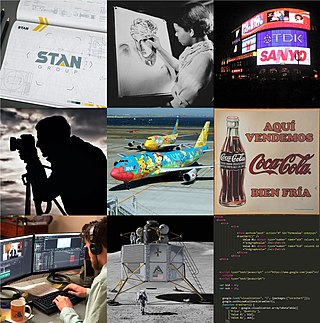Related Research Articles

Graphic design is a profession, academic discipline and applied art whose activity consists in projecting visual communications intended to transmit specific messages to social groups, with specific objectives. Graphic design is an interdisciplinary branch of design and of the fine arts. Its practice involves creativity, innovation and lateral thinking using manual or digital tools, where it is usual to use text and graphics to communicate visually.
Web design encompasses many different skills and disciplines in the production and maintenance of websites. The different areas of web design include web graphic design; user interface design ; authoring, including standardised code and proprietary software; user experience design ; and search engine optimization. Often many individuals will work in teams covering different aspects of the design process, although some designers will cover them all. The term "web design" is normally used to describe the design process relating to the front-end design of a website including writing markup. Web design partially overlaps web engineering in the broader scope of web development. Web designers are expected to have an awareness of usability and be up to date with web accessibility guidelines.
Usability engineering is a field that is concerned generally with human–computer interaction and specifically with devising human–computer interfaces that have high usability or user friendliness. It provides structured methods for achieving efficiency and elegance in interface design.
Information architecture (IA) is the structural design of shared information environments; the art and science of organizing and labelling websites, intranets, online communities and software to support usability and findability; and an emerging community of practice focused on bringing principles of design, architecture and information science to the digital landscape. Typically, it involves a model or concept of information that is used and applied to activities which require explicit details of complex information systems. These activities include library systems and database development.

Usability can be described as the capacity of a system to provide a condition for its users to perform the tasks safely, effectively, and efficiently while enjoying the experience. In software engineering, usability is the degree to which a software can be used by specified consumers to achieve quantified objectives with effectiveness, efficiency, and satisfaction in a quantified context of use.

Jeffrey Zeldman is an American entrepreneur, web designer, author, podcaster and speaker on web design. He is the co-founder of A List Apart Magazine and the Web Standards Project. He also founded the design studios Happy Cog and studio.zeldman, and co-founded the A Book Apart imprint and the design conference An Event Apart.
Interaction design, often abbreviated as IxD, is "the practice of designing interactive digital products, environments, systems, and services." While interaction design has an interest in form, its main area of focus rests on behavior. Rather than analyzing how things are, interaction design synthesizes and imagines things as they could be. This element of interaction design is what characterizes IxD as a design field, as opposed to a science or engineering field.
The user experience (UX) is how a user interacts with and experiences a product, system or service. It includes a person's perceptions of utility, ease of use, and efficiency. Improving user experience is important to most companies, designers, and creators when creating and refining products because negative user experience can diminish the use of the product and, therefore, any desired positive impacts; conversely, designing toward profitability often conflicts with ethical user experience objectives and even causes harm. User experience is subjective. However, the attributes that make up the user experience are objective.
Human-centered computing (HCC) studies the design, development, and deployment of mixed-initiative human-computer systems. It is emerged from the convergence of multiple disciplines that are concerned both with understanding human beings and with the design of computational artifacts. Human-centered computing is closely related to human-computer interaction and information science. Human-centered computing is usually concerned with systems and practices of technology use while human-computer interaction is more focused on ergonomics and the usability of computing artifacts and information science is focused on practices surrounding the collection, manipulation, and use of information.

User interface (UI) design or user interface engineering is the design of user interfaces for machines and software, such as computers, home appliances, mobile devices, and other electronic devices, with the focus on maximizing usability and the user experience. In computer or software design, user interface (UI) design primarily focuses on information architecture. It is the process of building interfaces that clearly communicates to the user what's important. UI design refers to graphical user interfaces and other forms of interface design. The goal of user interface design is to make the user's interaction as simple and efficient as possible, in terms of accomplishing user goals.

Fernanda Bertini Viégas is a Brazilian computer scientist and graphical designer, whose work focuses on the social, collaborative and artistic aspects of information visualization.
User experience design is the process of defining the experience a user would go through when interacting with a company, its services, and its products. Design decisions in UX design are often driven by research, data analysis, and test results rather than aesthetic preferences and opinions. Unlike user interface design, which focuses solely on the design of a computer interface, UX design encompasses all aspects of a user's perceived experience with a product or website, such as its usability, usefulness, desirability, brand perception, and overall performance. UX design is also an element of the customer experience (CX), which encompasses all aspects and stages of a customer's experience and interaction with a company.
Contextual design (CD) is a user-centered design process developed by Hugh Beyer and Karen Holtzblatt. It incorporates ethnographic methods for gathering data relevant to the product via field studies, rationalizing workflows, and designing human–computer interfaces. In practice, this means that researchers aggregate data from customers in the field where people are living and applying these findings into a final product. Contextual design can be seen as an alternative to engineering and feature driven models of creating new systems.

Mobile interaction is the study of interaction between mobile users and computers. Mobile interaction is an aspect of human–computer interaction that emerged when computers became small enough to enable mobile usage, around the 1990s.
Martin M. Wattenberg is an American scientist and artist known for his work with data visualization. He is currently the Gordon McKay Professor of Computer Science at the Harvard University School of Engineering and Applied Sciences.

Exhibit design is the process of developing an exhibit—from a concept through to a physical, three-dimensional exhibition. It is a continually evolving field, drawing on innovative, creative, and practical solutions to the challenge of developing communicative environments that ‘tell a story’ in a three-dimensional space.
The following outline is provided as an overview of and topical guide to web design and web development, two very related fields:

Kelly Goto is an American entrepreneur specializing in user experience design and contextual research. She was one of the first design researchers using design ethnography. She is the founder and principal at gotomedia and gotoresearch.
Design prototyping in its broader definition comprises the actions to make, test and analyse a prototype, a model or a mockup according to one or various purposes in different stages of the design process. Other definitions consider prototyping as the methods or techniques for making a prototype, or a stage in the design process. The concept of prototyping in design disciplines' literature is also related to the concepts of experimentation, and Research through Design (RtD).
References
- ↑ Gollander, Gili (2011-04-17). Aspects of Fashion/Trends in Web Design (PDF) (Thesis). Ben-Gurion University of the Negev. Archived from the original (PDF) on 2015-04-27. Retrieved 2013-04-06.
- 1 2 Davis, Amanda (2012). Hackwith. 1st edition. Rockable Press. ISBN 978-0-98710-266-9.
- ↑ Noam, Trachinsky; Ilanit Kabessa-Cohen; Gili Korman Gollander (12 Oct 2012). "Trends in Website Design". AIS Transactions on Human-Computer Interaction. 4 (3): 169–189. doi: 10.17705/1thci.00045 . Retrieved 2013-04-06.
- ↑ Jones, Brandon (2010-12-01). "Exclusive Interview with Kriesi from the Envato Marketplaces" (Press release). Envato. Retrieved 2013-04-11.
- 1 2 "Kriesi: The First Author to Sell $1,000,000 Worth of Items" (Press release). Envato. 2011-09-13. Archived from the original on 2003-01-15. Retrieved 2013-04-06.